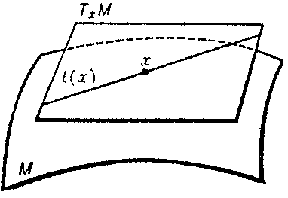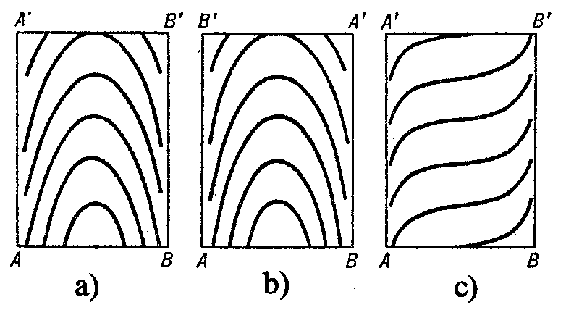Kneser theorem
on one-dimensional foliations (cf. Foliation) without singularities on closed surfaces of genus zero
A theorem that establishes properties of such a foliation depending on the presence or absence of closed leaves and describing the behaviour of non-closed leaves in domains bounded by closed leaves. The theorem is due to H. Kneser (who spoke about "regular families of curves on a surface" rather than of foliations [1]; for a modern account of the basic aspects of Kneser's theorem, see [2], [3]). Kneser's theorem is most often invoked in connection with trajectories of a flow without equilibrium positions on a torus or a Klein bottle (cf. Klein surface). The trajectories form a foliation of the type considered in Kneser's theorem.
A one-dimensional foliation (without singularities) on a surface is a family of non-intersecting curves ( "leaves" ) completely filling out the surface such that at each point there is a coordinate neighbourhood  in which the foliation appears, in terms of corresponding local coordinates
in which the foliation appears, in terms of corresponding local coordinates  , as the family of lines
, as the family of lines  (more precisely, the connected components of intersection of the leaves with
(more precisely, the connected components of intersection of the leaves with  have this equation). A foliation is called orientable if it is possible to define a "positive" direction on each of its leaves (to orient the leaves) so that for different leaves these directions are compatible, that is, under a continuous passage from leaf to leaf the positive direction never changes sign. The only orientable foliations are those consisting of trajectories of certain flows without equilibrium positions.
have this equation). A foliation is called orientable if it is possible to define a "positive" direction on each of its leaves (to orient the leaves) so that for different leaves these directions are compatible, that is, under a continuous passage from leaf to leaf the positive direction never changes sign. The only orientable foliations are those consisting of trajectories of certain flows without equilibrium positions.
Suppose that a direction field (field of line elements) is defined on a surface  , that is, with each point
, that is, with each point  is associated is a one-dimensional subspace
is associated is a one-dimensional subspace  of the tangent plane
of the tangent plane  at this point (if
at this point (if  lies in the Euclidean space, then
lies in the Euclidean space, then  can be represented by a line tangent to
can be represented by a line tangent to  at
at  , see Fig. a). If
, see Fig. a). If  depends smoothly on
depends smoothly on  , then the integral curves of this direction field form a one-dimensional foliation that may or may not be orientable.
, then the integral curves of this direction field form a one-dimensional foliation that may or may not be orientable.

Figure: k055540a
The main content of Kneser's theorem relates to the case when the foliation possesses both closed and non-closed leaves. It states that the latter fill out the domains bounded by the former, where these domains can be of three types only (see Fig. b, where it is understood that in each of the rectangles a), b) and c) the upper side has to be glued to the lower one, with  glued to
glued to  and
and  to
to  . For example, from a) one obtains here the "Kneser ring" , see the figure in the article Differential equations on a torus). If the surface has only one closed leaf, then in the rectangle one must glue in addition the left- and right-hand sides. a) b) c)
. For example, from a) one obtains here the "Kneser ring" , see the figure in the article Differential equations on a torus). If the surface has only one closed leaf, then in the rectangle one must glue in addition the left- and right-hand sides. a) b) c)

Figure: k055540b
If a non-closed leaf lying in one of these domains is extended unboundedly in one direction, then it winds itself closer and closer to the closed leaf bounding the given domain or to one of the two closed leaves bounding it. If the non-closed leaf is extended to the other side, it winds itself to the same closed leaf (on the other side) or to the second of the above-mentioned closed leaves.
There can only be a finite number of domains of type a) and b), a non-orientable domain of type b) being possible only on a Klein bottle and only for a non-orientable foliation; domains of type c) can be finite or countable in number.
Kneser also proved that the case when a foliation has no closed leaves is possible only for a non-orientable foliation on a torus and in this case there is a closed line  transversal to the foliation and intersecting all the leaves. (In the general case, when it is not assumed that the leaves are smooth and the foliation is defined by some direction field, transversality is understood in the sense that at each point of
transversal to the foliation and intersecting all the leaves. (In the general case, when it is not assumed that the leaves are smooth and the foliation is defined by some direction field, transversality is understood in the sense that at each point of  there is a coordinate neighbourhood in which the leaves are defined by the equation
there is a coordinate neighbourhood in which the leaves are defined by the equation  , and
, and  by the equation
by the equation  .) Concerning this, see also Differential equations on a torus.
.) Concerning this, see also Differential equations on a torus.
References
| [1] | H. Kneser, "Reguläre Kurvenscharen auf Ringflächen" Math. Ann. , 91 : 1–2 (1924) pp. 135–154 |
| [2] | B.L. Reinhart, "Line elements on the torus" Amer. J. Math. , 81 : 3 (1959) pp. 617–631 |
| [3] | A. Aepply, L. Markus, "Integral equivalence of vector fields on manifolds and bifurcation of differential systems" Amer. J. Math. , 85 : 4 (1963) pp. 633–654 |
Comments
In the literature often the following consequence of the above-mentioned classification is called Kneser's theorem: Any foliation of the Klein bottle has a compact leaf.
The "Kneser rings" mentioned above are also called  -dimensional Reeb components. See e.g. [a1] and [a2].
-dimensional Reeb components. See e.g. [a1] and [a2].
References
| [a1] | C. Camacho, A.L. Neto, "Geometric theory of foliations" , Birkhäuser (1985) |
| [a2] | G. Hector, U. Hirsch, "Introduction to the geometry of foliations" , Vieweg (1981) |
Kneser theorem. Encyclopedia of Mathematics. URL: http://encyclopediaofmath.org/index.php?title=Kneser_theorem&oldid=17863